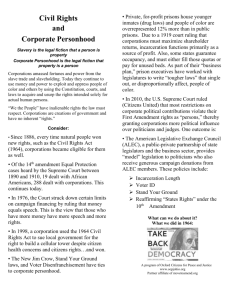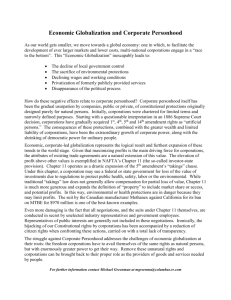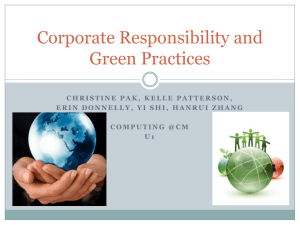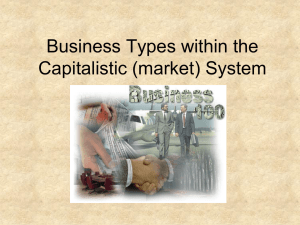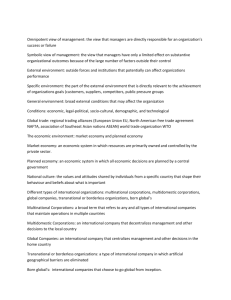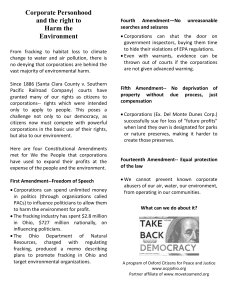Phase 2 - COLLABORATIVE INQUIRY Week 6. Unit 2.3.
advertisement
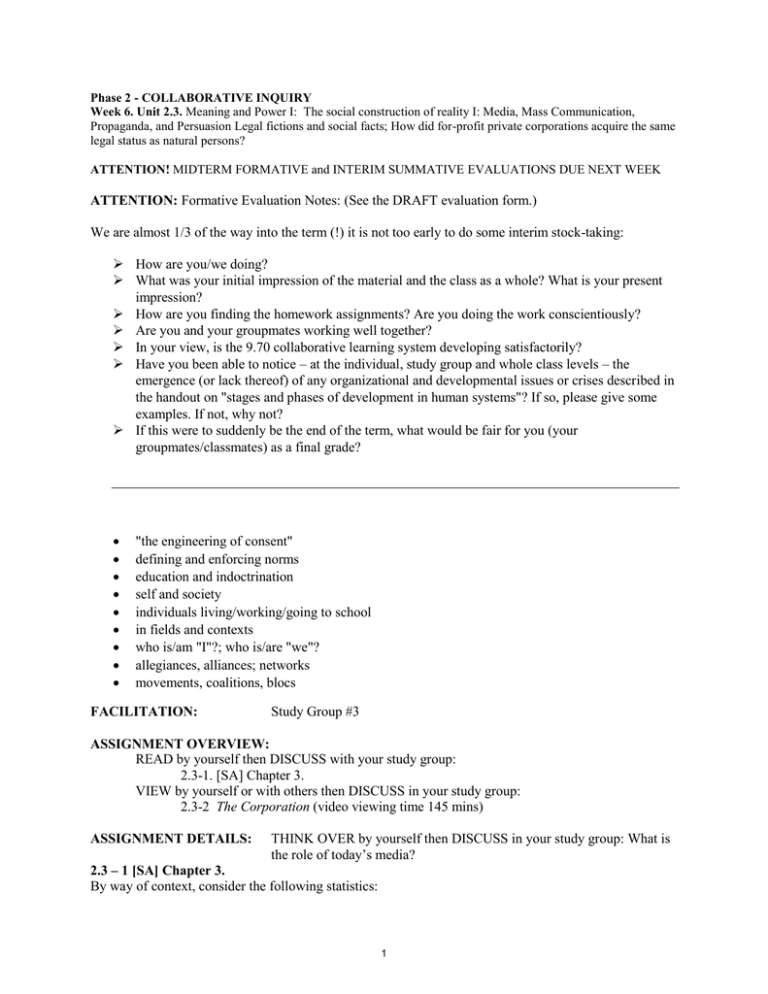
Phase 2 - COLLABORATIVE INQUIRY Week 6. Unit 2.3. Meaning and Power I: The social construction of reality I: Media, Mass Communication, Propaganda, and Persuasion Legal fictions and social facts; How did for-profit private corporations acquire the same legal status as natural persons? ATTENTION! MIDTERM FORMATIVE and INTERIM SUMMATIVE EVALUATIONS DUE NEXT WEEK ATTENTION: Formative Evaluation Notes: (See the DRAFT evaluation form.) We are almost 1/3 of the way into the term (!) it is not too early to do some interim stock-taking: How are you/we doing? What was your initial impression of the material and the class as a whole? What is your present impression? How are you finding the homework assignments? Are you doing the work conscientiously? Are you and your groupmates working well together? In your view, is the 9.70 collaborative learning system developing satisfactorily? Have you been able to notice – at the individual, study group and whole class levels – the emergence (or lack thereof) of any organizational and developmental issues or crises described in the handout on "stages and phases of development in human systems"? If so, please give some examples. If not, why not? If this were to suddenly be the end of the term, what would be fair for you (your groupmates/classmates) as a final grade? "the engineering of consent" defining and enforcing norms education and indoctrination self and society individuals living/working/going to school in fields and contexts who is/am "I"?; who is/are "we"? allegiances, alliances; networks movements, coalitions, blocs FACILITATION: Study Group #3 ASSIGNMENT OVERVIEW: READ by yourself then DISCUSS with your study group: 2.3-1. [SA] Chapter 3. VIEW by yourself or with others then DISCUSS in your study group: 2.3-2 The Corporation (video viewing time 145 mins) ASSIGNMENT DETAILS: THINK OVER by yourself then DISCUSS in your study group: What is the role of today’s media? 2.3 – 1 [SA] Chapter 3. By way of context, consider the following statistics: 1 In 1983, 50 corporations controlled almost all of US news media; today there are 6 major media outlets: Time Warner, Walt Disney, Viacom, Rupert Murdoch's News Corp., CBS Corporation and NBC Universal. Together, the "big six" absolutely dominate news and entertainment in the United States see: http://www.freepress.net/ownership/chart The average American adolescent watches 3-4 hours of TV daily, seeing 20,000-40,000 commercials a year. (How many brutal acts? Shootings? Murders, Mass killings?) How many sustained episodes of police riots and military violence. The average height/weight of American women is 5’4"/140 lbs. The average height/weight of the American woman model is 5’11"/117 lbs. 80% of American women report being dissatisfied with their appearance. In 2001, US advertising expenditures exceeded $230 billion (up from $105 billion in 1980). Media corporations have spent $111.3 billion lobbying lawmakers and federal regulators since 1996. Between 1995 and 1998, media companies (excluding telecoms) gave more than $30.9 million to candidates for federal political office and party committees. An estimated $2 billion is spent annually to target juvenile consumers. At 3 years of age, 1 American child in 5 is making specific requests for brand-name products. Channel One’s in-classroom broadcast, featuring 2 minutes of commercials for every 10 minutes of news is compulsory on 90% of school days in 80% of classrooms in 40% of US middle and high schools. Cigarette manufacturers spend over $9.57 billion/year (> $26.2 million/day) on advertising. Almost 500,000 children (under 18’s) are estimated to have become regular smokers during 2002. Mass media comprise the main source of health-related information for a majority of adolescents. The January 2010, US Supreme Court decision in Citizens United vs Federal Elections Commission removes all legal limits to spending by corporations which now become constitutionally free to influence outcomes in federal state and local elections. Over the years the focus of this study unit has evolved to keep pace with the times and the emergence of new and clearly relevant social problems at the nexus where mass communication, propaganda, and persuasion intersect with actual and virtual realities of everyday contemporary life and technology. For example, past classes studied how iconic images propagated via the "mass media” influence us by encouraging us to accept without challenge prevailing social conceptions (e.g. about human diversity -- as in the case of gender identity). We’ve also looked at “images of humanity and nature” and considered both how these are shaped and how they influence our behavior. A constancy across the years has been in the effort to use timely and pertinent real world situations and developments to illuminate the process of social influence. We are all at least dimly aware that words and acts and images presented in compelling ways (via mass media and otherwise) manage to develop in target audiences a belief in the appropriateness or inappropriateness of certain attitudes (thoughts and feelings) and particular patterns of behavior (actions). Marketers are active everywhere and are always endeavoring to influence our beliefs, values and behavior; getting us to trust the claims made regarding the importance, value, and utility of whatever it happens to be that they are selling. All this “marketplace jargon” is introduced here, in part, because we have found that the aforementioned nexus of social influence cannot even begin to be seriously approached, observed or discussed with a view toward meaningful comprehension, without taking surrounding conditions (e.g. conditions prevailing in our contemporary political economy) properly into account. The modern corporate state is 2 increasingly marked by the emergence of extreme concentrations of wealth and power in the hands of a self-styled elite minority: the owners (stockholders) and operators (directors) of large for-profit business corporations organized to maximize self-interest (as measured in "the bottom line" (aka “the 1 percent”) Events of the recent past suggest to me (SLC) that if left unbridled by public regulations, (constitutional amendment?). Corporate enterprise, the excessive accumulation of economic power in a relatively few highly competitive private hands, invariably exerts manifestly malign and harmful influences on the long ongoing effort of some individuals and groups to achieve a more sustainable, more just and more genuinely sustainably democratic polity. More recent classes have thus been drawn to explore some significant social psychological issues associated with the increased concentration of corporate political and economic control in fewer and fewer hands (e.g. over contemporary media technology as a whole, including the form and content of messages communicated). Wary of the tendency for large for-profit corporate conglomerations of capital to become concentrated in fewer and fewer hands, we stepped back a bit further last year and asked how our worldviews, valuesystems, and lifestyles are systematically shaped by persuasive media communications and commercial "messages" whose form and content are carefully contrived to reflect and reinforce the interests and objectives of a relatively small and self-selected community of extremely wealthy and powerful corporate elites. 2.3-2. The Corporation, directed by Mark Achbar and Jennifer Abbott, 2004, digital production. Once again this year, we pick a theme: “corporate personhood?” and organize the unit around the viewing of a (2003) film called The Corporation1. As its name implies, the film is a "documentary" with a point of view: it undertakes to explore (from a critical vantage point) the nature and rise of the dominant sociopolitical and economic institution of our time. Footage from pop culture, advertising, TV news, and corporate propaganda and documentary films illuminates various aspects of the social influence that is exerted upon us by large and powerful corporate entities. In parts that are particularly pertinent for our purposes, the film presents viewers with the little known fact that for profit corporations have long lobbied for and have gradually acquired most of the rights originally constitutionally guaranteed only to certain classes of natural persons (human beings). Gradually, however, admittedly merely artificial and legally contrived, socially organized, profit-seeking, privately held (corporate) conglomerations of capital have come to enjoy the privileged status of "persons" putatively entitled to enjoyment of the same constitutional rights as natural persons ("We the people ..."), while being legally incapable of shouldering the same social responsibilities. To be more precise, in a series of opinions that began in 1886 and culminated in last year's Citizens United decision, the US Supreme Court has repeatedly ruled in ways that corporations are entitled to the same constitutional protections as "natural persons" and, for a wide variety of legal intents and purposes are no different than “natural persons” in the rights legally accorded to them. Sometimes, corporate personhood has been further termed a “legal fiction” or qualified as “juristic” or “legal” or “artificial,” but Directed by Mark Achbar and Jennifer Abbott; produced by Mark Achbar and Bart Simpson; edited by Jennifer Abbott; written by Joel Bakan; with narration written by Harold Crooks and Mark Achbar; narrator: Mikela J. Mikael. It is based on the book The Corporation: The Pathological Pursuit of Profit and Power, by Joel Bakan, "Winner of 24 international awards, 10 of them audience choice awards including the Audience Award for documentary in world cinema at the 2004 Sundance Film Festival." 1 3 the point for present purposes is that the judicial branch of our federal government has ruled that, (e.g.) constitutional guarantees of “equal treatment of all persons under law” applies equally to "we the people" and to corporations and that this entitles them to be treated no differently from you or me or any other natural person (we the people). Arguably this is more than a merely absurd and lamentable “category mistake”. Our inquiry will focus on some of the implications of this state of affairs for our present economic and political predicament. For more details: Image removed due to copyright restriction. The film does not depict the origin and development of the strange and mischievous 'legal fiction" of “corporate personhood.”2 But it does the next best thing: it grants for purposes of argument the idea of corporate personhood and then goes on to ask a disturbingly interesting question: "what kind of a person is it”? http://www.thecorporation.com/ Inquiry reveals the “corporate personality" to be dominated by a spirit of narrow financial self-interest and a callous disregard for the rights of others. The filmmakers next try to more precisely pinpoint the exact nature of the "psychopathology" of the "corporate person". Toward this end, they use a general mental health checklist based on diagnostic criteria developed by the World Health Organization and the American Psychiatric Association (whose diagnostic and statistical manual – DSM-IV – is the standard diagnostic tool of psychiatrists and psychologists in the U.S.). Using these categories, they outline the psychopathologies of the corporate "person." 2 For a good account of the process in which private, for profit, corporations (i.e. conglomerations of working capital advanced by owners/investors) came to be recognized as “legal persons” entitled to the same constitutional rights as natural persons consult Ted Nace’s very readable history: “GANGS OF AMERICA”: The Rise of Corporate Power and the Disabling of Democracy, at www.gangsofamerica.com/ See also: “The Santa Clara Blues: CORPORATE PERSONHOOD versus Democracy”, by William Myers at: www.iiipublishing.com/afd/santaclara.html also, “The Corporate "Person": A New Analytical Approach to a Flawed Method of Constitutional Interpretation, LOYOLA UNIVERSITY CHICAGO LAW JOURNAL (2005) by J.M.Krannich, at http://works.bepress.com/jess_krannich/2 4 Point by point, through numerous corporate case histories drawn from a broad universe of market activity, the film documents instances in which the pursuit of profit (itself an activity that corporate managers are legally bound to adhere) leads corporations to harm workers, undermine human health, and the health and welfare of other animals, and degrade the biosphere. It depicts the for-profit corporation as “legally required” to behave in preeminently selfish, inherently amoral, callously "rational", and necessarily socially and environmentally destructive and deceitful ways. As a conscienceless "person" the corporation behaves as an "externalizing machine" that does not suffer from guilt, yet can mimic the human qualities of empathy, caring and altruism, using various corporate facsimiles thereof. We might choose to argue whether the corporate embodiment of laissez-faire capitalism fully meets the diagnostic criteria of a "psychopath" or “sociopath”, but the fact remains that for more than 100 years, the remorseless rationale of "externalities" has been invoked to excuse the myriad unintended consequences of economic transactions – many of which have led to much illness, death, poverty, pollution, exploitation and injustice. Financial markets exist to create wealth. As the film shows, even world-scale disasters can be profit centers. Carlton Brown, a commodities trader, recounts with unabashed honesty the mindset of gold traders while the collapsing twin towers crushed their occupants. The first thing that came to their minds, he tells us, was: "How much is gold up?" We are organisms. Mortal human beings. By contrast corporations are immortal. They can exist indefinitely and have no built-in limits on what, who, or how much they can exploit for profit. In the fifteenth century, the enclosure movement began to put fences around formerly common grazing lands so that they might be privately owned and exploited. Today, just about every molecule on the planet – including the water that falls as precipitation – is up for grabs. In a bid to "own it all", corporations claiming more and more constitutional rights are increasingly economically and politically controlling natural resources, patenting animals and plants, and commodifying bits and pieces of human DNA. Are there any things so precious, vulnerable, sacred, or important that they must be managed in the public interest? Or is everything reducible to mere units of economic exchange? Should the public insist that governments draw regulatory boundaries to protect the public against corporate exploitation? Should governments be inviting corporations into domains of exploitation from which they were previously barred? What is your view of "corporate personhood"? In social systems of all kinds and sizes, various means (mass media appeals, propaganda and persuasion) are developed for the purpose of encouraging members to believe in and conform with particular mental and behavioral norms. After doing the assignments, you should be able to: • define "mass communications"; 5 • identify some of the factors that may reinforce (or undermine) the perceived credibility of communications; • understand how advertising and/or media appeals achieve "the engineering of consent"; • define "emotional contagion"; • define "corporate personhood" • compare and contrast: reason and passion; prosocial, asocial, and/or antisocial influences; • understand why it is so difficult to distinguish between education and indoctrination; • define and distinguish between the primacy effect and the recency effect; Think About the Following Questions and Issues: With particular respect to yourself, consider: • The impact on you of televised news events and "docudramas" • The impact on you of televised commercial messages • Your susceptibilities to "Infotainment" • Your ways of coping with "information overload” Collect some examples of "persuasive" and "unpersuasive" newspaper/magazine adverts; identify the persuasion tactics at work in the ad (attractiveness, identification with fame/beauty/power; credibility, use of vivid images, appropriateness to context, etc.). How might things be different if “corporate personhood” were to become a thing of the past; if corporations were required to limit their activities to those explicitly defined in their charters and were otherwise prevented from unduly influencing our political process? Over the course of a day (or week) try to identify and take note of instances in which you encounter an effort by an individual or group to influence your thoughts, feelings, and actions. Include "live" encounters with salesclerks and other strangers; as well as "virtual" encounters via new media and also interactions with friends, families, groupmates, classmates, roommates, housemates, etc. In the case of media appeals, look for commercial and non-commercial messages coming from as broad as possible variety of mass media sources (TV, radio, print, billboards, product packaging or labeling etc.). Take note also of corporate logos and instances of “brand placement”. Discuss whether the attempts in question were successful in influencing you: and if so how and to what extent, if not why not. 6 MIT OpenCourseWare http://ocw.mit.edu 9.70 Social Psychology Spring 2013 For information about citing these materials or our Terms of Use, visit: http://ocw.mit.edu/terms.
